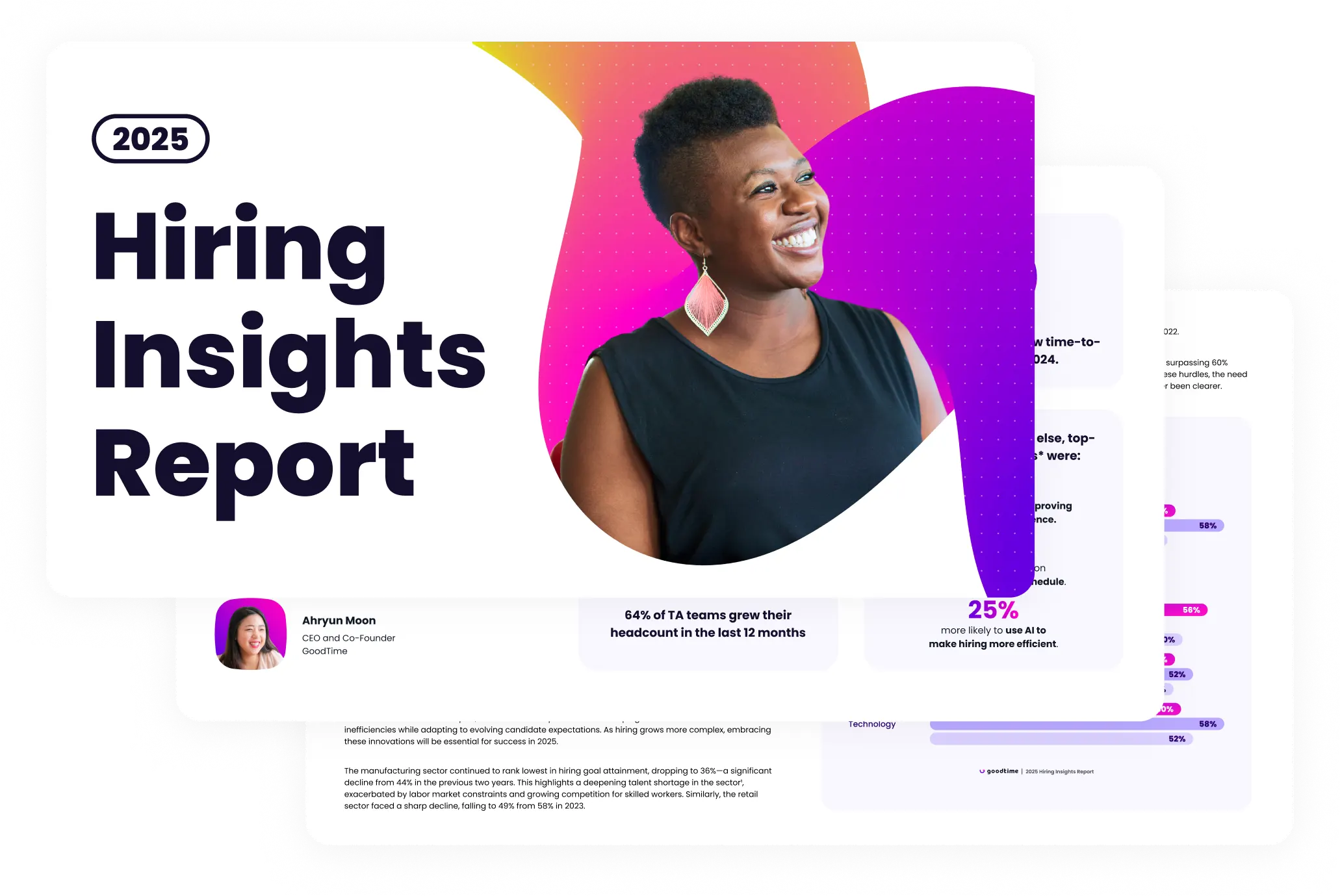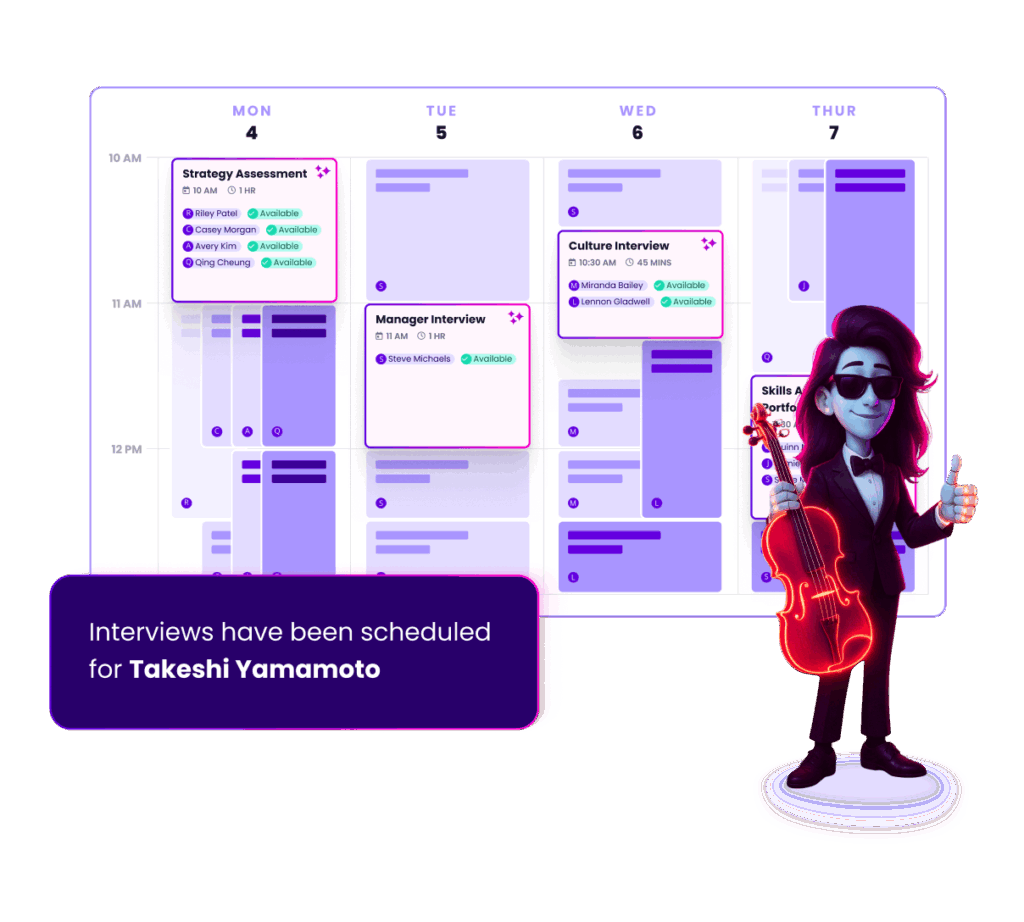Table of Contents
Top candidates are on every talent acquisition (TA) team’s wish list, and proactive outreach is critical to attract them. The challenge is identifying where to do that outreach for optimum visibility. How can TA teams find top talent sooner and bring them into the pipeline more efficiently?
Social recruiting is a simple and effective solution. As of 2024, nearly 95% of all internet users visit social platforms at least monthly, with the average user spending over two hours daily on these sites. Whoever your candidates are, they’re on social media.
Social recruiting gives your employer brand a presence on popular social media platforms, allowing you to build key connections with target talent. Learn why one leading expert says social recruiting is essential today and how to integrate it into your TA pipeline.

Unlock 2025’s top hiring strategies: Insights from 500+ TA leaders
Be the first to uncover deep hiring insights specific to your sector — straight from the highest-performing TA teams.

Social recruiting uses social media platforms to promote your employer brand, reach top candidates, and build relationships that lead to hires. It’s a proactive approach combining best practices in social media marketing with a clear understanding of your ideal candidates. When done well, it reaches the right candidates with the right message at the right time.
Social media recruiting works as a valuable tool in today’s competitive networking and candidate sourcing environment. TA has come a long way from the traditional methods of filing cabinets full of resumes and Rolodex files packed with contact information that might lead a recruiter to the perfect match for a company.
When everything shifted to digital and the cloud, companies’ scope of talent acquisition expanded dramatically. Today’s TA teams can search extensive databases for the ideal talent match, and companies vie for candidates’ attention on digital platforms, including social media.
The result is a much more competitive hiring environment and a focus on personalization. In the GoodTime 2024 Hiring Insights Report, 46% of TA leaders said that candidate relationships have become more critical in the past 12 months, while the landscape itself has become more competitive:
Social media recruiting provides TA teams with advantages on both fronts. Giving candidates curated insights into who you are as a brand strengthens your employer brand to position you ahead of the competition. It also builds positive candidate relationships through back-and-forth conversations.
Here are the best practices to make your social recruiting strategy efficient and effective.
Develop a long-term strategy
Social recruitment works best as part of recruitment marketing, a multi-platform process that engages top talent and inspires them to approach you.
Before starting to formulate a social recruiting strategy, consider your high-level TA goals and how marketing fits in. Social media will be particularly well-suited to some objectives, such as securing a target number of inbound inquiries. Identify what will signify your social recruiting strategy has succeeded, and build your plan around that goal.
Leverage each platform’s strengths
Each social media platform satisfies different user needs and targets different demographics. Understanding those needs and demographics lets you place content where it will have the greatest impact.
For instance, LinkedIn appeals particularly to professionals in their 30s and 40s with higher levels of formal education. According to the Pew Research Center, 53% of Americans with bachelor’s degrees use LinkedIn, compared to just 10% of those with a high school degree or below.
Here are a few other demographic insights from the same source:
- Adults with six-figure incomes are more likely to use Twitter
- Women use Pinterest far more than men
- YouTube is the most popular platform overall by 15 percentage points
- New grads and earlier-career professionals, ages 18 to 29, gravitate to Instagram and TikTok
Content format also matters. Instagram is image-heavy and ideal for building your employer brand, while Facebook and LinkedIn are more text-friendly and suitable for thought leadership.
Emphasize authenticity
One of the main purposes of recruitment marketing content is to showcase an employer’s authentic identity. Almost 95% of surveyed students think it’s essential for an employer to be authentic and genuine with candidates. Social recruiting helps TA teams establish that connection from the first touchpoint.
Value-centered content helps employers communicate authenticity and connect with candidates. According to the Society for Human Resource Management (SHRM), the most popular type of recruitment marketing content speaks to employer values. Forty-five percent of job seekers flagged it as “important,” placing it above content related to the company’s purpose and culture.
Engagement is the main purpose of social recruiting. It’s the spark of connection that encourages candidates to reach out and connect, especially if the person isn’t actively job-searching.
Connecting with passive candidates
In a Boston Consulting Group survey, 41% of job seekers described themselves as not currently searching but “open to a job change if presented with a good offer.” What constitutes a good offer varies by person and position, and it’s up to TA teams to uncover those motivations.
The first step is opening the lines of communication with value-rich content focused on something other than recruiting or hiring. Examples include:
- Highlighting recent employee achievements
- Sharing company updates
- Welcoming new team members with celebratory posts
- Discussing industry news and developments
Remember that passive candidates may not be actively networking. The TA professional’s job is to start a conversation by sparking the candidate’s interest.
Starting and continuing conversations
Stacy Donovan Zapier encourages recruiters and TA pros to put the “social” first in social recruiting.
“Every recruiter should absolutely engage on social media,” she says. “Just get that dialogue, that conversation started. That’s what great recruiters do. We’ve always been social; social media just allows us to do that more effectively.”
Connecting with candidates on social media requires patience, especially when working with passive job seekers. SHRM encourages TA teams to be patient and continue offering valuable interactions. The key is to continue the back-and-forth until an appropriate opportunity arises, or you can add them to your pipeline organically.
Candidates need to trust brands that reach out to them on social media. The first step to earning that trust is showing them who you are as a company.
Doing so requires strong, clear, and consistent employer branding. Clarifying your brand is an essential first step to recruiting on social media, where candidates will get all their context clues from your text and visuals.
How does employer branding work?
Employer branding communicates your culture, interaction style, and value to employees. What you say is part of the picture, but so is how you say it and how you look doing it.
Picture a job candidate scrolling their LinkedIn feed and seeing a few organizations engaged in recruitment marketing. One offers a sense of warmth and connection, posting frequently about team community service outings. The other emphasizes fun and celebration, with bright colors and employees at exciting events.
Even with this simplified example, you likely feel one or the other drawing you in. That’s the importance of employee branding. It shows what someone can expect from you as an employer, first as a candidate and later as an employee.
Stacy Donovan Zapar agrees, offering this explanation:
“Employer branding is absolutely key. Candidates want to see what it’s like to work at your company… They want to peek between the blinds and see what it’s really like to work there. That’s what strong talent branding is all about.”
Incorporating employer branding into social recruiting
Understanding your employer brand is step one. It’s essential to understand the message you send with your recruitment marketing materials, regardless of whether employer branding has been an intentional part of your TA process.
Consider the image style, color scheme, and tone you use when communicating with candidates and employees. Those elements make up your consumer brand, and it’s important to incorporate them as consistently as possible.
Finally, clarify your employee value proposition. Know what you offer candidates and aim for your social recruiting strategy to communicate that value.
It’s the practice of using social media platforms like LinkedIn, Facebook, and Instagram to promote jobs, connect with talent, and build your employer brand.
By sharing authentic content like employee stories and company updates, social media helps showcase your culture and values, building trust with candidates.
LinkedIn works well for professional roles, while Instagram and TikTok attract younger audiences. Facebook is great for a broader reach, and Twitter is useful for thought leadership.
Yes, it’s a great way to connect with candidates who aren’t actively job hunting but might be interested in the right opportunity.
Track follower growth, engagement rates, and the number of applications or inquiries generated from social media posts.
Share real employee experiences and behind-the-scenes content, and avoid overly promotional posts. Authenticity builds trust with candidates.
While organic posts help, paid ads on platforms like LinkedIn can boost visibility and target specific candidates, especially for niche roles.
Identify your target audience, create a content calendar, and tailor your posts to each platform. Track results and adjust as needed.
TA teams are now focusing on improving overall efficiency, upgrading the hiring technology, and building candidate relationships to keep up with an increasingly competitive landscape, as GoodTime’s 2024 Hiring Insights Report reveals:
Social recruiting moves companies toward each of these needs. It provides a richer candidate experience, with job-seekers getting a better sense of the company through more personalized content.
However, remember that as powerful as social recruiting is, it only makes up part of the candidate experience. GoodTime’s candidate experience platform allows you to provide applicants with a seamless recruiting experience, complete with a single hub of contact where they can manage interview schedules, view feedback, and more.
Get a demo today and see how exceeding candidate expectations can help you improve hire quality and build strong employee relationships early.
Upgrade your hiring journey with AI
GoodTime’s AI agents orchestrate the entire hiring journey — screening, scheduling, messaging, and more — so talent teams hire faster with a better candidate experience.





